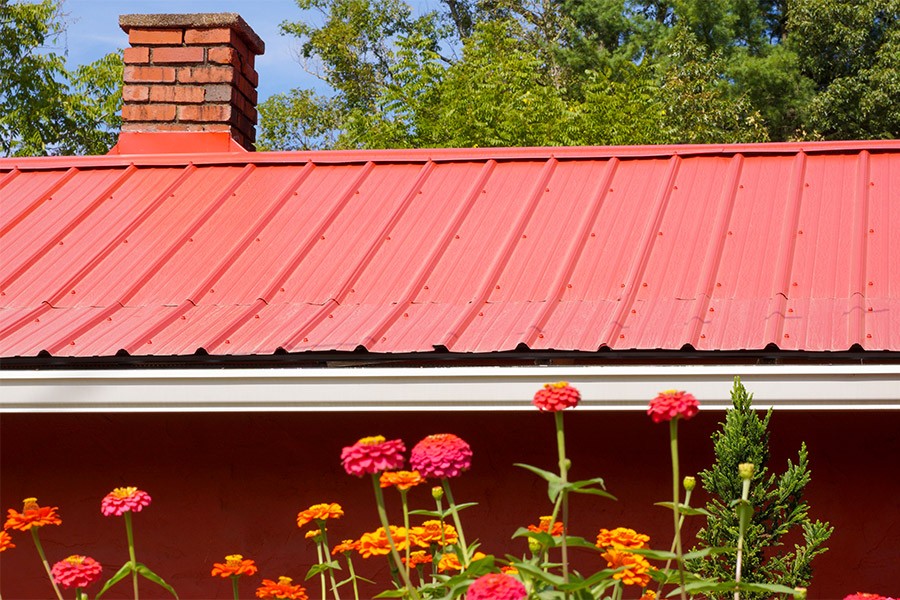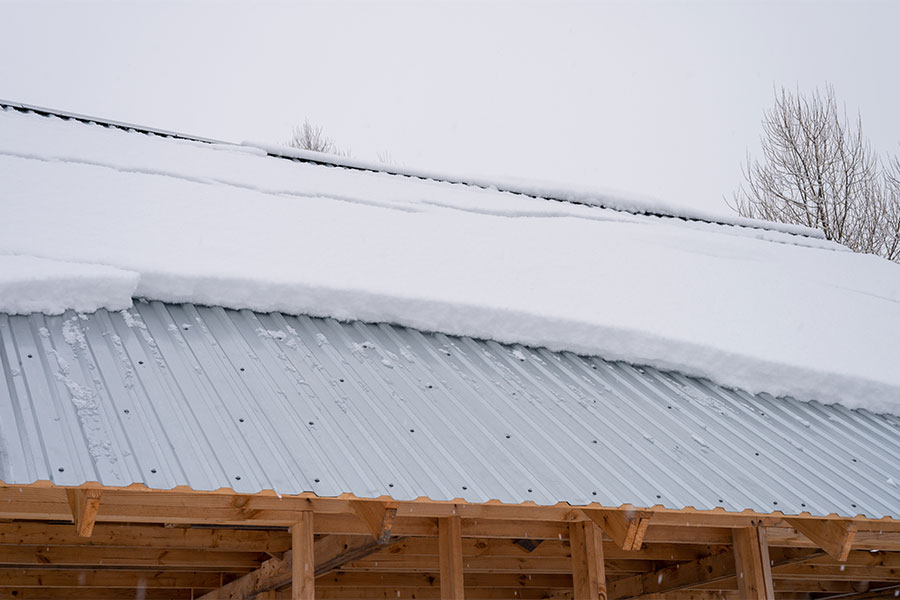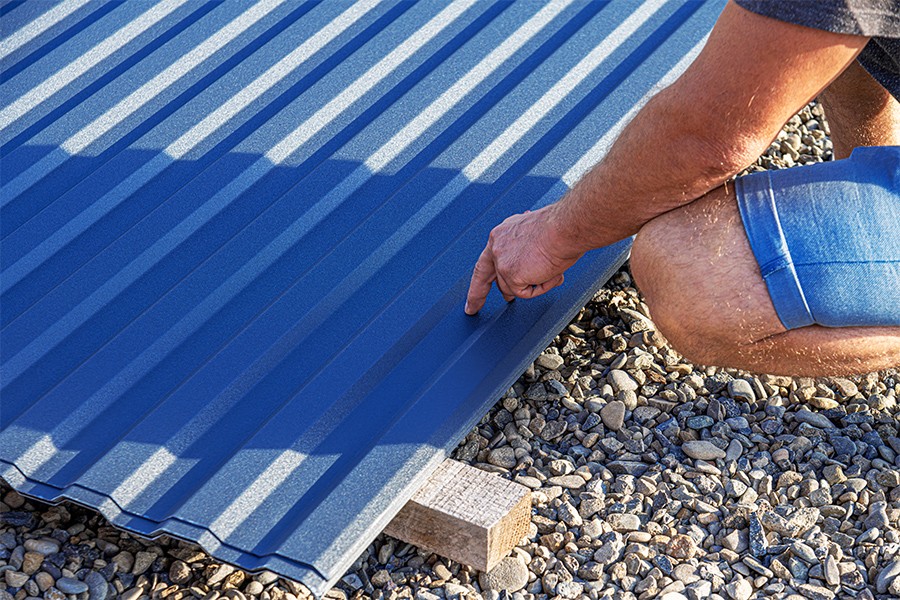Let’s face it: when you live in a state like Montana, you need to be prepared for just about anything, especially during wildfire season. From May through October, the Big Sky State often faces flames, wildfires sprouting up from Custer Gallatin National Forest to Glacier National Park. According to a study by the Insurance Information Institute, Montana has the highest percentage of properties at risk of wildfire damage at 29%.
Naturally, homeowners impacted by wildfires want to take precautions to protect their loved ones and property from wildfire damage. This includes their housing materials. When choosing roofing materials, fire resistance is one of the top factors to consider—that’s why we recommend metal roofing.
Over the years, metal roofing has become one of the most sturdy, reliable, and energy-efficient options available. In Montana, residents choose metal roofing so their buildings can be better protected against any harsh elements. But what about wildfires? Are metal roofs fire-resistant?
Below, we’ll explore the qualities of metal roofing and how its naturally durable structure can be a benefit during wildfire season.
Answering the Question: Are Metal Roofs Fire-Resistant?
Metal Roofs: Fireproof vs. Fire Resistance
When answering the question “Are metal roofs fire-resistant?”, we first need to examine the word “fire-resistant.” Fireproof and fire resistance are often used interchangeably, but they are not the same —especially with metal roofing.
Let’s begin with the word “fireproof.” In reality, not much is actually fireproof. Anything can get hot enough to get destroyed when a wildfire rages across the countryside—including metal roofs. A metal roof can’t provide 100% foolproof fire protection. A truly fireproof material would not catch on fire or contribute to the spread of flames, and it’s rare to find a material that can make that bold of a claim.
That’s why we prefer the label “fire-resistant” with metal roofing. Fire resistance refers to a material’s ability to withstand fire for a set period of time without contributing to the spread of flames or without losing its structural integrity. So while metal roofs have excellent, verified fire-resistant properties, they are not completely immune to fire damage. They do, however, perform better than shingles or cedar planks when facing the flames. This makes a metal roof the best roof for wildfire resistance.
There are different class systems that define how fire resistant a roofing material is, labeled as Class A, B, C, or unrated. Class A is the best rating a roofing material can receive for fire resistance. To its credit, most metal roofing products are considered Class A rated. However, this is often limited to just the product as it is, also known as the “stand-alone” fire rating. For the whole metal roof to be considered Class A rated, the entire roofing system would need to be compliant for fire resistance, including the roof’s underlying materials. This is called the “by assembly fire rating.”
Mitigate Risk of Wildfire Damage: Why Choose Metal Roofing
While metal roofs are not “fireproof,” their fire resistance is a huge asset to your property. Just like adding sprinklers to a building or smoke detectors, upgrading your building with fire-resistant roofing materials—like metal roofing—is an investment in safety and property protection.
Most metal roofing materials are intrinsically fire resistant. Steel is the most popular choice for fire-resistant metal roofing, as it has a high melting point. Aluminum, as well, has a low ignition point and does not contribute to the spread of flames. Copper has a high melting point, as well, and does not burn or release any toxic fumes when exposed to fire. While it has a relatively low melting point, Zinc can withstand high temperatures without compromising its structural integrity.
Overall, the inherent properties of metal roofing materials help contribute to its fire resistance, lending a hand in defending your home or commercial building. Here are a few of the characteristics of metal roofs that contribute to their fire-resistant natures:
- Noncombustible – Metal is a non-combustible material, meaning it does not burn when exposed to fire. Unlike flammable materials such as wood or asphalt, metal roofing does not contribute to the spread of flames.
- Heat Reflectivity – Metal roofing materials have high reflectivity, meaning they can reflect a significant amount of the sun’s heat away from the building. This property helps in reducing heat absorption, minimizing the risk of fire caused by heat buildup.
- High Melting Point – As previously mentioned, metals used in roofing—such as steel, aluminum, copper, and zinc—have high melting points. This means they can withstand high temperatures before reaching their melting point, providing increased resistance to fire.
- Limited Combustible Fuel – Since metal roofing panels do not have combustible components, such as oils or organic materials that can contribute to the spread of flames, they do not provide fuel for fire.
- Resistance to Ember Attacks – Metal roofs are less susceptible to ember attacks, which are common during wildfires. The smooth surface of metal roofing helps prevent embers from entering the structure, reducing the risk of ignition.
- Structural Integrity – Metal roofing does not easily collapse or fail when exposed to fire, allowing the roof to provide protection to the building and its occupants during a fire event.
Additional Benefits of Metal Roofing and Siding
Along with its fire-resistant properties, metal roofing (and siding, for that matter) provides extra benefits for your building, adding long-lasting value to your property.
- Longevity – Metal roofs are incredibly strong, so they need to be replaced far less frequently than asphalt roofs. Metal roofs will carry a manufacturer’s warranty of roughly 30-50 years and last much, much longer, often up to 70 years.
- Durability – Thanks to the material’s inherent sturdiness, metal panels are able to withstand the test of time without corroding or cracking. Additionally, rust-proof coatings and protection add to the roof’s ability to withstand wear and tear.
- Weather Resistance – Metal roofs are able to withstand intense weather conditions in a way that asphalt and other roof options cannot. Whether it’s strong winds, hail, ice storms, or snow, metal roofs keep their structural integrity during all of these conditions.
- Aesthetics – Since metal panels can be painted and repainted, you can choose the metal roof color that matches the style of your building. There are a lot of metal panel color options to choose from along with panel style, concealed fasteners versus exposed fasteners, and texture.
- Noise Reduction – Despite the common misconception, metal roofs are not loud and can even be quieter than shingles. They’re excellent at protecting your home from noise pollution, and you can add insulation boards and upgrades to dampen any noise that comes with heavy rain or hail.
Wildfire Resistant Roofing: Metal Panels vs. Other Roofing Materials
There’s really no competition when comparing the fire resistance of metal panels versus. other roofing materials. Look at it this way: if an ember lands on a steel roof versus a cedar or asphalt roof, it is less likely to catch your structure on fire. Here are a few reasons why roofing materials like asphalt, thatch, and wood shingles don’t hold a candle to metal roof panels:
- Combustible Nature – Roofing materials like wood shingles, asphalt shingles, or thatch can ignite and burn when exposed to flames or high temperatures. Their combustible nature increases the risk of fire propagation and can contribute to the spread of flames.
- Lower Melting Points – Non-metallic roofing materials generally have lower melting points compared to metal. For instance, asphalt shingles can soften and melt at relatively low temperatures, leaving the underlying structure vulnerable to fire damage.
- Fuel Source – Roofing materials that contain organic components, like wood or thatch, can serve as fuel for fire, sustaining flames and further endangering your property.
- Structural Integrity – When exposed to fire, non-metallic roofing materials are less sturdy than metallic ones, easily weakening, deforming, and collapsing.
Keeping Your Structure Fire Resistant
Installing metal roofing on your property plays a major part in protecting your home from wildfire damage, but there are other precautionary measures you can take to ensure your structure is fire-resistant.
- Clear Vegetation Near the Roof – Trim any trees or shrubs near your roof, as overhanging vegetation can serve as fuel sources and increase the risk of fire damage.
- Remove Debris from Your Roof – Regularly clean your roof and keep it clear of leaves, branches, and other flammable materials.
Have Your Roof Routinely Maintained – Regularly inspect your roof for signs of damage and have it repaired as soon as possible.
Invest in Fire-Resistant Roofing Materials, Install Metal Panels
If you have specific questions about metal roofing’s fire resistance or how to best protect your next residential or commercial metal roofing project, we’re here to help. At Great Northern Metal Company, our Bozeman metal roofing experts can make expert recommendations to ensure you have all the information you need to better protect your structure from fires. Get a quote today or give us a call at (406) 624-0435—we’d be happy to answer any questions!


